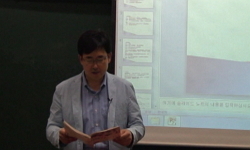회화에서의 선의 의미는 그린다는 원초적인 행위를 비롯하여 화가 자신의 예술세계를 정확하게 드러내는 수단으로 그 역사는 선사시대 동국벽화 및 암각화에 나타난 선線부터 현대의 회화...
http://chineseinput.net/에서 pinyin(병음)방식으로 중국어를 변환할 수 있습니다.
변환된 중국어를 복사하여 사용하시면 됩니다.
- 中文 을 입력하시려면 zhongwen을 입력하시고 space를누르시면됩니다.
- 北京 을 입력하시려면 beijing을 입력하시고 space를 누르시면 됩니다.
회화에 있어서 線의 연구 : 석도화론과 작품을 중심으로 = A Study of Line in Painting - Focused on painting theory of Sukdo
한글로보기https://www.riss.kr/link?id=T8941928
- 저자
-
발행사항
[]: 청주대학교, 2003
- 학위논문사항
-
발행연도
2003
-
작성언어
한국어
- 주제어
-
KDC
652.000
-
발행국(도시)
대한민국
-
형태사항
iv, 78 p..
- 소장기관
-
0
상세조회 -
0
다운로드
부가정보
국문 초록 (Abstract)
회화에서의 선의 의미는 그린다는 원초적인 행위를 비롯하여 화가 자신의 예술세계를 정확하게 드러내는 수단으로 그 역사는 선사시대 동국벽화 및 암각화에 나타난 선線부터 현대의 회화작품에 이르기까지 오래되었다.
또한 단순히 대상의 외형을 재현한다는 개념에서 작가 내면의 심리상태까지도 표현되어지는 회화의 한 요소로 인식되어있는 수단이기도 하다.
이처럼 선이란 회화에서 가장 기본적이고 중요한 요소로서 중국회화에 있어서 선에 대해 언급한 화론 또한 적지 않았다.
중국에서 화론의 시작은 춘추시대 공자의 논어에서 나온 회사후소繪事後素라는 말로부터 그 역사를 볼 수 있으며, 그 이후 약 4백여편에 가까운 화혼이 발표되었고 그중 명明(1368-1643) 청淸(1644-1911) 540여 년 간에 150여 편의 화론이 발표되었다. 이러한 많은 화론들 중에 명말 청초에 활동한 석도의 화론인 고과화상화어록苦瓜和尙畵語錄(1707년)은 회화에 있어 선線 즉, "획劃"의 의미를 재인식 시켰다고 할 수 있다.
석도가 활동한 명말 청초의 시대는 왕권이 교체되는 혼란의 시기였으며 이 시대에는 많은 유민화가들이 등장하게 된다. 그 중 대표적 화가라고 할 수 있는 석도는 자신의 회화관을 화론을 통해 말하기를 "회화에 있어 한번 그음이 그 시작이며 동시에 끝이다."라는 일획론 一劃論을 주장하였다.
석도의 화론은 중국 예술 정신의 바탕인 유儒·불佛·도가道家 삼가사상 과 자신의 생활 체험을 토대로한 선조형과 그작용 그리고 회화창작에 있어 표현적인 기교와 회화의 근본원리에 관계한 주관적인 사고를 논한 이론이다. 화론에서 석도가 말하는 일획이란 단순히 조형예술에서 최소기본단위로서 한 줄의 선을 의미하는 것 외에 무無의 관념세계와 유有의 형상, 주관과 객관, 등의 합일合一을 추구하는 미학원리로 나타난다.
예술의 근원은 눈에 보이지 않는 정신세계로부터 비롯되며 이러한 예술이 예술로서 성립되기 위해서는 그것의 가시화, 조형화가 필요하다.
따라서 예술가는 눈에 보이진 않는 근원적 이법理法을 실천화하여 창조한다 말할 수 있다. 먼저 석도의 화론은 산수화이 창작에 대해 논한 화론이며 일획은 바로 예술의 근원으로서의 관념적 세계와 그것을 실천화하는 형상세계를 일원화 한 것이라 할 수 있다.
석도는 말하기를 화가는 허정한 마음으로 대상을 관조하여 주관과 객관이 서로 존재를 잊고 하나가 되는 경지를 이루어 대상의 본질을 직관적으로 파악한 후 일획의 경지를 더욱 완전하게 하기 위해서는 자연이 깊은 관찰을 통하여 자신의 체험을 바탕으로 한 창작에 있어 기존의 화법에 얽매이기보다는 다양한 필법을 가능하게 해준다고 말한다.
바로 이것이 석도가 말한 일획의 원리이며 화어록은 단순한 산수화의 창작론을 떠나 새로운 창작개념에 대해 논한 것이다.
그러므로 화어록은 일획이라는 선조線條만을 논한 화론은 아니며 창작에 있어 근본원리를 논한 화론인 것이다. 석도는 창작에 있어 태초의 시작과 비유, 하나가 흩어져서 만물을 이루었다. 라고 말하면서 "그림은 일획으로 시작하여 일획으로 끝난다."라는 한번 그음이 그림의 시작이며 동시에 일획으로 끝난다라는 철학적 사상을 바탕으로한 이론이다.
또한 회화 창작에 있어 법칙이 없으며, 그 대상마다 고유의 그리는 법이 있다 라는 말을 하였는데 이것이 바로 석도가 화론을 통해 말하고자 하는 "무법이법無法以法"의 창작정신인 것이다.
당시의 권위적이고 모방적이며 답습적인 화단에 화가자신의 독창적이고 개성적인 화법을 펼칠 것을 주장한 화론으로 청초의 개성파 화가에 미친 영향이 크다고 할 수 있다.
이런 점에서 본 논문에서는 석도가 화론을 통해 말하고자하는 진정한 선線의 개념이 어떠한 것인지를 살펴하고자 하며 선승이면서 평생 작품에만 몰두했던 개성파의 대표적인 화가인 석도의 화어록을 분석, 석도 회화에서 선이 화면에서 어떻게 구현되어지는지를 연구하고자 한다.
다국어 초록 (Multilingual Abstract)
The meaning of line in painting represents from original action of drawing and is the means of expressing authors artistic world. The lines of painting is raged from caves mural painting and carve in prehistoric age to modern paintings. And they repro...
The meaning of line in painting represents from original action of drawing and is the means of expressing authors artistic world. The lines of painting is raged from caves mural painting and carve in prehistoric age to modern paintings. And they reproduce the contour of objects and as well are recognized as the way of expressing authors internal and mental state. Thus, lines are fundamental in paintings and important elements. In Chinese paintings, many theories about paintings, the lines have often been mentioned.
Chinese theories of paintings were originated from Hoesahuso of the analects of Confucius in the Spring and Autumn age, and since then, about 400 theories of paintings were published. Among them about 150 theories were published for 540 years in Myung dynasty (1368-1643) and Chung dynasty (1644-1911). Among them, in the end of Myung and beginning of Chung, theory of Sukdo kokwahwasanghwaeorok made the meaning of lines, a stroke to be recognized again.
The age when Sukdo worked was the end of Myung and the beginning of Chung, time of disorder of replacement of throne. Many drifting painters were generated. Among them, Sukdo was a representative painter and said about his view of painting as follows: a stroke in painting is a start and also an end in suggesting A stroke Theory.
His theory was based on three big thoughts, Confucianism, Buddhism and Taoism and also grounded on his own life experiences of line plastic and its action in explaining the subjective thoughts relating to technical skills of expression and fundamental principles of paintings.
A stroke of Sukdo is simply a minimal unit of plastic art and also means the ideological world of nothing and the form of existence, subjectivity and objectivity leading the final union as esthetic principle.
The origin of art is started from invisible mental world and requires the visualization and formation as a art. Therefore artists adopt the original and invisible method and create the world. First, the theory of Sukdo is about the creation of landscape and his stroke is the origin of art and unification of formative world of his practices and ideological world.
According to Sukdo, the artists should meditate the objects as empty-minded, forget the distinct existence between object and subject and lead to complete the perfect state of unification. Thus they understand the essence of objects with intuition and finish the state of a stroke. For this purpose, they should deeply observe the nature and foster their experiences and then they make creations. The experiences from changing nature enables various method instead of sticking to traditional painting method.
It is the very theory of Sukdo principle of a stroke and his hwaeorok was about the discussion of concept of new creation differently from simple creation theory of landscape. So, hwaeorok is not theory of line formation but discussed the fundamental principle of creation. Sukdo said that the beginning of the creation world and comparison, on thing is scattered to form the nature and added that the painting is start from a stroke and ends in a stroke. Thus his theory is based on such philosophy.
Also, he said that there were no laws in painting creation and there were specific drawing method of individual objects. It is his no law is law , sprit of his creation.
Differently the current painters who were authoritative and imitator, the suggested the creative and personal painting method and gave many impacts on Individualism of painters in beginning of Chung dynasty.
In this respect, I would like to examine the concept of line in what he suggested in his theory as a Zen priest for his all life and analyzed his Hwaeorok to study the realization of lines of his paintings.
목차 (Table of Contents)
- 목차
- 국문초록 =ii
- 1. 서론 =1
- 2. 繪畵에 나타나는 線의 개념 =4
- 2.1. 동양회화에서의 선 =4
- 목차
- 국문초록 =ii
- 1. 서론 =1
- 2. 繪畵에 나타나는 線의 개념 =4
- 2.1. 동양회화에서의 선 =4
- 2.2. 서양회화에서의 선 =9
- 3. 석도화론의 역사적 배경 =11
- 3.1. 일획론의 사상적 연원 =18
- 3.2. 일획론의 본체와 의미 =25
- 4. 석도 회화에의 線의 구현 =41
- 4.1. 일획으로서의 선조線條 =41
- 4.2. 화면에 나타나는 경계境界 =45
- 4.3. 여백으로서의 허虛와 실實 =52
- 4.4. 화면에 나타나는 서書 =56
- 결론 =60
- 참고문헌 =62
- <도판> =65
- ABSTRACT =76












